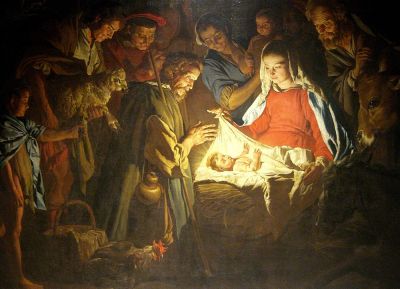La parola presepe deriva dal latino e significa mangiatoia, cioè il luogo dove Gesù fu deposto appena nato. II primo presepe fu realizzato da San Francesco la notte di Natale del 1223 a Greccio, un paesino vicino ad Assisi. Il Santo volle rappresentare la scena della natività affinchè tutti, anche i più umili, capissero il significato profondo di quell’evento. Francesco allestì un presepe vivente dentro una grotta. Gesù, Giuseppe e Maria erano interpretati da persone vere, così come erano veri il bue e l’asinello. Si racconta che la gente arrivò alla grotta in processione e rimase senza parole perché sembrava proprio di essere a Betlemme davanti alla Sacra Famiglia. Da allora in breve tempo l’usanza si diffuse in tutto il mondo cattolico. Nel corso dei secoli, statuine di legno, terracotta e cera sostituirono le persone in carne e ossa e la semplice scena della natività si arricchì di elementi paesaggistici e di tanti altri personaggi che fanno da cornice a quella principale nella grotta.
Displaying a Nativity scene is a Christian tradition practiced for many years around Christmas time and it is still relevant to this day. Often adorned with animals, a manger, angels, and shepherds, this display focuses on the birth of Jesus and enhances the Christmas experience with a beloved symbol of the season.
The Nativity scene has more than one name: the manger scene, the crib, the presepe, and more. This scene has no specific fashion of being displayed. Some Nativity scenes are static and made of stone, wood or glass, while others may use live actors to make a living scene. Smaller sets usually consist of only baby Jesus, Mary, Joseph, and a manger, while larger sets include shepherds, the Three Wise Men, angels, and various animals as well. If animals are included, they are often a sheep, a donkey, an ox, and a camel. Depending on how large or elaborate the set may be, the figures used in the scene may vary.
It is common for each individual figurine in the display to be added as the winter days pass by, such as one would with an advent calendar. The baby Jesus is the last figure added and he is placed in his crib on Christmas day. This completes the entire set and it often remains on display until January 8 of the next year. Other figurines may vary in placement, too. For example, a participating individual may add the Three Wise Men during the week after Christmas instead of adding them before Jesus.
The act of setting up the Nativity scene is said to have been created from an idea by St. Francis of Assisi many years ago in 1223. The Nativity scene was displayed in a nearby cave and many Christian citizens visited the area to pay their respects and pray. This event spread around Italy and to other countries, from the Vatican to the U.S., and the set itself varies depending on who puts it together. In some locations, the Nativity scene is displayed publicly, while other areas may enjoy a private Nativity scene in their personal homes.
The Nativity scene usually begins its display on December 8, around the time Christmas trees would be brought home for trimming and decorating. The individual or group displaying the scene then decides whether to present the figurines all at once or whether they will add them one at a time as Christmas approaches.
The Nativity scene allows onlookers to visualize and celebrate both Jesus’ birth and humble, simple beginnings. People are allowed to personalize their scenes by deciding where the figurines are positioned, which figurines are present and whether or not they should be added day-by-day or altogether. Whether someone celebrates a Christian holiday or more secular-styled holiday, the Nativity scene is truly a beauty to behold. Happy Holidays!



